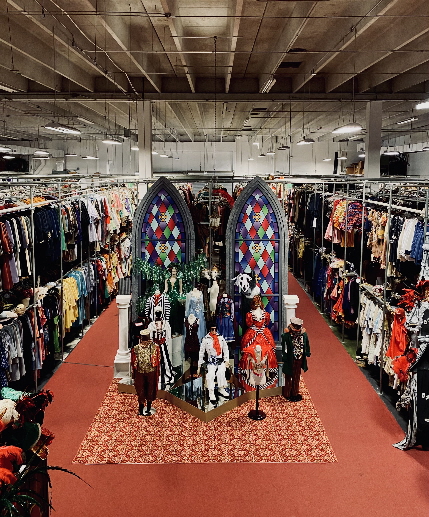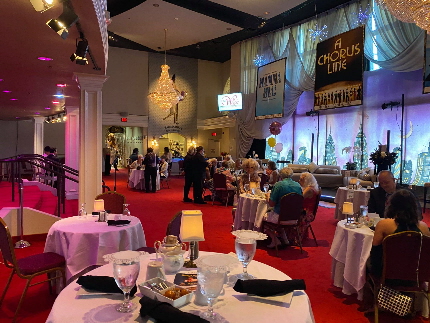
By Bill Hirschman
When the pandemic curtain came crashing down on Costume World Theatrical, arguably the largest wardrobe supplier in the nation, the staff realized 175 costumes were stranded in locked-down closets in deserted theaters across the country – even some in Europe.
Far worse, checking with its clients off-Broadway, in regional theaters, opera companies and schools, CEO and executive managing producer Marilynn Wick discovered scores of pending contracts – especially for summer festivals – had evaporated in a matter of days.
Accustomed to grossing multiple million dollars a year, the Florida-based company now expects to fall short of $150,000 for 2020, earning as little as $1,000 during one nadir of a month, Wick said.
“During 9/11 people were very frightened to go out into the world and our business declined about 30 percent…. This is three times worse. All of a sudden everything’s stopped,” Wick said of a paradigm now familiar to theater-supporting businesses in the United States.
Wick’s adjoining Costume Museum closed down its public tours of original wardrobes from Broadway productions and high-profile revivals such as the original Tony-winning gowns designed by Sir Cecil Beaton and worn by Julie Andrews in My Fair Lady.
And the final blow: The company’s sister operation, The Wick Theatre in Boca Raton, shuttered its own highly-anticipated production of A Chorus Line after one preview and two performances. Even today, as Wick comes to work, the white line and mirrors of the minimalist set stand there mocking.
But although crippled financially like so many other similar companies, the 44-year-old firm with a satellite in Dallas is doggedly fighting to recover.
After a couple of hiatuses and spending tens of thousands of dollars on measures to battle COVID-19, the theater has staged cabarets regularly since June in its large lobby, attracting a steady clientele of returning seniors. Months and months of negotiations with Actors’ Equity continue but the theater has committed to a late April resurrection of A Chorus Line to kick off a full season in its auditorium. At least Wick hopes so.
But the inventory of 1.2 million costume pieces hangs idle except for a handful reserved for a few education-related productions. She has been feeling out her regular clientele including light opera troupes and summer stock groups who are pessimistic that they will be operating fully this coming summer.
“All of my theatrical wardrobing business came to a complete standstill despite our many attempts to encourage our clients to, ‘look ahead to the future’ and continue to do business with us, however speculatively,” she said.
Like so many theater-related companies, she has laid off much of her staff, some of whom have worked for her for 20 years. She won a government loan, has been selling off assets, and is offering steep discounts to the few companies who might still be producing later this year.
But observers believe its one edge is Wick herself, a 70-something force of nature whose outsized personality has driven a self-built career that began in real estate in New York, Pennsylvania, Georgia, South Carolina and California. She then created an industrial window cleaning firm for high-rise buildings based in Florida as well as a salvage business.
The costume business had a modest origin in the mid-1970s when a friend asked the single mother to create a Santa Claus suit for her husband’s company Christmas party. With her young girls, Kelly and Kimberly, she built the outfit on their dining room table.
Unexpected subsequent word of mouth requesting pandas, Easter bunnies and Halloween creatures convinced her there was a market. She opened the company in Boca Raton in 1976, took out newspaper ads and reached out to theaters.
The amassing, manufacturing, altering and designing costumes over the decades grew exponentially with acclaim on People magazine, the Today Show and nominations for regional theater awards.
Indeed, only having 175 costumes on the road when the pandemic hit was a lucky stroke; normally, the company has about 1,000 pieces on stages on any given week, she said.
Recovering their stock from shuttered theaters required intense protracted efforts. “For three months we sat silent and we were worried,” she admitted. When the costumes finally began returning, her reduced work force faced a gargantuan task. “Every box, every garment had to be sprayed outside and disinfected. We were in these jumpsuits with rubber gloves because we so afraid to be touching anything.”
The pandemic came at a terrible time. The costume supply industry has been decimated over the past three to six years as some theaters, school drama programs and citizens holding lavish costume parties turned to Amazon and even Party City. At one time, the National Costume Association had 350 members; now it has 100 left, she said. Once there were three major costume suppliers based in the Dallas area; now she is the only one left. She has closed five other outlets of her own satellite stores in recent years in cities like Pittsburgh.
Indeed, her company was once the second or third largest supplier in the country. But she became the largest in 2005 when she bought out the massive stock of Dodger Costumes in New York City. She now has original wardrobes from over 35 Broadway productions such as the Guys and Dolls revival, over 90 Tony nominated shows and 38 Tony winners created by William Ivey Long and Tony Walton among others.
But she has refused to surrender. After a few weeks’ closure in the spring, she began the expensive refit of her Wick Theatre and Costume Museum facility in Boca Raton. Then she began producing or hosting the procession of revues and cabaret acts.
Determination fits her pattern, friends aver. Wick invested more than a million dollars of her own money and took out a bank loan in 2013 to lease and then buy the foreclosed Caldwell Theatre building to become her performing venue in addition to her warehouse. She funded massive renovations of the building with the appearance of high-dollar elegance to attract Palm Beach County’s well-heeled denizens. Then she re-opened the expanded Costume Museum and installed a fine dining restaurant decorated with artifacts from New York City’s Tavern on the Green auctioned off in 2010.
Since then, her list of subscribers has grown year after year to about 3,800 last season, although the post-pandemic figure is about 1,500.
The specific realities of running a theater have been challenging for someone who never helmed one, no matter how involved she was on the periphery. But her advantage, observers have said, is her extensive business experience including specializing in rescuing and resurrecting failing companies.
Wick’s mercurial nature and tough business practices weighed against clear affection and support for performers have won her unmitigated adoration from some, lasting antagonism from others. Dealing with her warm loud laugh and a quick sharp temper, some people swear they would work for her anytime, some say they will never work for her again, and some of the latter have returned.
She has specialized in large cast mainstream classic musicals preferred by her older audience of snowbirds and retirees. Sometimes she uses recorded tracks, sometimes live bands. Obviously, among the shows strengths’ is her costumes including those created fresh for each show.
The shows are immensely popular with her subscription audience and receive critical reviews varying from laudatory to unenthused. Some shows have made national headlines such as Lee Roy Reams starring as Dolly Levi and Leslie Uggams in a troubled outing of Mame.
But in the past months, she has been limited to the lobby shows with a variety of acts ranging from supper club revues to drag comedians to name performers like Billy Stritch. The performers deliver from a small bandstand or on the wide steps leading to the shuttered auditorium. She says she usually has filled the 55 socially distanced seats.
Francesca Daniels, a semi-retired finance expert who moved to Florida from Beverly Hills, is a huge fan of the productions and Wick herself: “The cabaret is amazing. It’s elegant, it’s charming. I felt like I was in the Upstairs at the Downstairs club in New York City…. It was like I closed my eyes and I felt like I was there at a time when the greats were playing.”
Besides replacing the air conditioning system to increase air flow and filtering, she ensures a list of precautions are followed, even installing a full-time attendant cleaning in the restrooms throughout the evening. Her website and her weekly emails to patrons includes a video about the efforts (https://tinyurl.com/y2uofkgp), meant to comfort her fans, many of whom are in the danger zone for the virus age-wise.
“Every person calls the box office and they say, I watched that video and I feel very safe to come. That’s another thing that every theater should be doing,” Wick said.
And in a classic Wick-style fillip of wry showmanship, she sometimes dresses full-sized dummies in her idle costumes to resemble Elvis, Elton John, Michael Jackson and Marilyn Monroe and sticks them in the empty seats used to maintain social distancing.
While many South Florida theater leaders are pessimistic about when theater-hungry audiences will feel it is safe to return, Wick’s regulars appear to be comfortable. “There are a percentage who are not fearful,” Francesca Daniels said. “They wear masks, distance appropriately and have a good time. And there are people who stay locked up in their room. It’s a choice.”
All of this is meant to restore at least a minimal cash flow and more importantly to keep the theater’s profile vibrant in the consciousness of a clientele who tell her how anxious they are to get back inside the main auditorium to see full-fledged productions.
The cabarets and a couple of seriously socially distanced “events” in the auditorium “weren’t in any way money-makers for me, but they did keep my audience engaged and some local performers employed,” Wick said.
She is focusing on the performance option that few other theater supply companies have because until theater across the country resumes with any magnitude — what Wick expects no earlier than next fall if luck holds — the alleys of racked costumes across 42,000 square feet lie dormant.
The next step is resuming producing full musicals in her 345-seat auditorium, knowing that initially she can only seat about 200 people.
She has contacted some of the actors for A Chorus Line for a possible early April rehearsal. She has brought back some regular employees for other shows like veteran director Dominic Ruggerio who volunteered that he welcomed the opportunities after spending three months driving a bus.
Earlier, she had planned to have TV star Cindy Williams head a spring production of Nunsense, but now she hopes to feature her in a one-woman production.
But Wick is too experienced a businesswoman to bet too heavily.
“Anticipating another shutdown to come soon, we are girding ourselves for another lull that, hopefully, we can survive,” she said. “Am I optimistic? I have to be… I have little say in the matter at this point and there’s no sense in looking backward.”










 A PaperStreet Web Design
A PaperStreet Web Design

One Response to Wick Theater’s Costume Arm: All Dressed Up, Few Places To Go